Can Pet Birds Be Left Alone? Key Insights for Owners
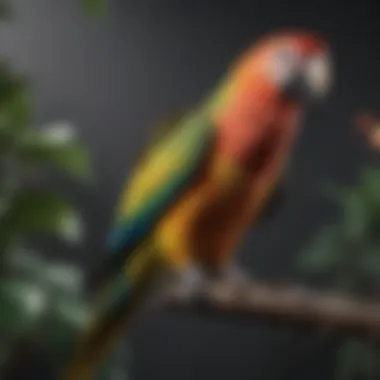
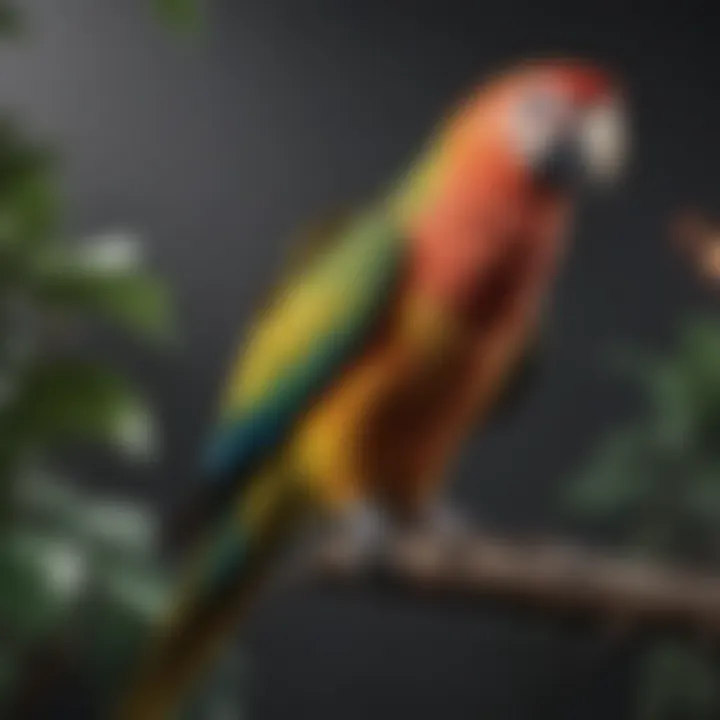
Intro
When it comes to keeping pet birds, many bird owners grapple with a pressing question: Can these feathered companions be left alone? This question isn’t merely about the physical act of leaving them in a cage; it hits at the core of their well-being. Birds are inherently social creatures. While some species can manage with solo time better than others, understanding the implications of leaving them unattended is crucial for any responsible pet parent.
In this article, we will navigate the broad landscape of bird care when it comes to solitude. We’ll explore key areas—birds’ social requirements, their behavioral quirks, and the environment they thrive in. The end goal is simple: equipping owners with the knowledge to make informed decisions about their pets, ensuring they can live a happy, enriched life even in their owners' absence.
Care Tips
For bird owners, establishing a structured care routine is essential. Birds require daily attention, not just to avoid loneliness but also to maintain their health and happiness. Let’s unpack some of the daily practices that can help foster an enriching environment.
Daily Care Routines
Birds, like humans, thrive with consistent routines. Starting each day by feeding your bird at the same time can create a comforting schedule. This could look like:
- Morning feeding: Give them fresh fruits, grains, or seeds.
- Health check: Observe their behavior for any signs of stress or discomfort.
Routine plays into not just feeding but also playtime. Fifteen to twenty minutes of interaction every morning can set the tone for the day.
Cage Setup and Maintenance
A well-designed cage can make all the difference. Birds need space to stretch their wings. The larger the cage, the better; however, it must be equipped properly. Here’s what to consider:
- Perches at different heights: Mimic a natural environment.
- Variety of toys: Rotate toys regularly to prevent boredom.
Moreover, cleanliness cannot be overlooked. Regular cleaning helps prevent illness and keeps their habitat inviting. Every week, a thorough scrub down of the cage is advisable.
Hygiene and Cleaning Practices
Maintaining hygiene is paramount. Here are some important tips:
- Daily Spot Cleaning: Remove any uneaten food and droppings promptly.
- Weekly Deep Clean: Disinfect perches and toys using bird-safe cleaning solutions.
Ensuring a clean environment not only helps the birds stay healthy but also improves their overall mood.
Seasonal Care Adjustments
Seasonal changes can affect a bird's well-being. During hotter months, additional access to water plays a vital role. Meanwhile, in colder months, ensuring the cage is draft-free is critical. Consider utilizing heating lamps for tropical birds during winter, and this will provide a warm retreat when temperatures drop.
Behavioral Insights
Understanding a bird's body language is essential for nurturing a healthy relationship. Their behaviors tell their story—emotions, comfort levels, and social needs are all embedded in their actions.
"Listening to your bird’s non-verbal cues is as critical as their chirping. Each head tilt or feather ruffle conveys an emotion you must learn to interpret."
Understanding Bird Body Language
Birds communicate through various subtle cues. A few to keep an eye on include:
- Puffed feathers: This can indicate they are cold or relaxed, depending on context.
- Chirping: While it's often a sign of happiness, persistent loud squawking may hint at distress or boredom.
Common Behavioral Issues and Solutions
Common issues include plucking feathers or excessive screamimg. Recognizing these problems early can help mitigate them. Techniques include:
- Engaging their minds with puzzles or foraging toys.
- Regular social interaction, either with their human or other birds.
Positive Reinforcement Techniques
Using treats for desired behaviors can build trust between you and your bird. Simple commands such as come here or step up can be positively reinforced. Use pieces of fruit or favorite seeds as rewards to encourage learning.
Social Interaction Needs
Birds, especially social species like parrots or cockatiels, thrive on companionship. If you plan to be away for extended periods, consider a second bird or a safe, interactive toy that mimics social interaction.
Nutrition Guides
A bird’s diet directly influences its behavioral health and longevity. Ensuring they have a well-rounded diet is non-negotiable.
Essential Diet Components
A balanced diet consists of:
- Seeds and pellets as a staple.
- Fresh fruits and vegetables as regular treats.
Safe and Toxic Foods
Be aware of what’s off-limits. Foods such as avocados and chocolate can be toxic to birds. Always conduct research if uncertain about a new food item.
Supplements and Treats
Consider incorporating supplements that aid in feather health or digestive support. Nutritious treats such as cuttlebone can also provide calcium, essential for bone health.
Feeding Strategies for Different Species
It’s vital to recognize that different species have unique dietary needs. For instance, larger parrots might need more protein compared to finches. Tailor their meals accordingly, providing a diverse menu that stimulates their taste buds.
Wellness and Health
Monitoring your bird’s health goes beyond diet. Regular checkups and observation will keep them on their toes—well, you know what I mean.
Routine Health Checkups
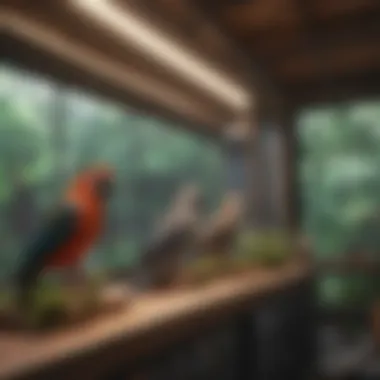
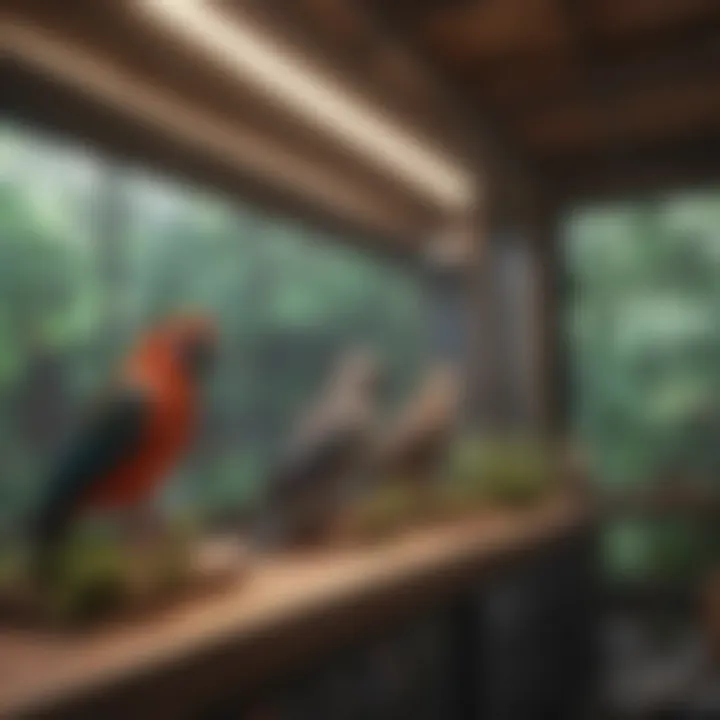
Like most pets, routine veterinary visits are crucial. They should occur about once a year unless particular health concerns arise.
Identifying Symptoms of Illness
Being observant can make all the difference. Watch for signs like lethargy or changes in eating habits that could hint at illness. If you notice any unusual behavior, consult a vet.
Preventative Care and Vaccinations
Certain birds may require vaccinations or preventative treatments depending on their species. Keeping an open dialogue with your vet is essential to ensure your bird stays happy and healthy.
Mental and Emotional Well-being
Birds experience stress just like us. Providing enrichment activities—whether through interactive toys or outside time—can significantly boost their mood, mitigating feelings of loneliness when left alone for longer periods.
Enriching Activities
Providing stimulating activities to keep your bird busy is essential to their well-being. Nobody wants a bored bird.
Toys and Playtime Ideas
Here are some great ideas for playtime:
- Kong toys filled with treats
- Puzzle toys that require problem solving
Training and Tricks
Birds not only enjoy interactive play but also thrive under training challenges. Teaching them simple tricks keeps them engaged and strengthens your bond.
Outdoor Activities and Interaction
Safe outdoor excursions can be beneficial. Use a harness designed for birds to explore outside under supervision. Exposure to natural sunlight can benefit their mood and health—just don’t forget the sunscreen if needed!
DIY Projects for Mental Stimulation
Creating DIY toys can be a fun and flavorful way to enrich their environment. Simple tasks might involve creating homemade foraging toys using paper towel rolls, stuffing them with treats, providing a scavenger hunt experience for your pet.
These insights and care tips provide a strong foundation for understanding how to support your pet bird when they are alone and what measures can ensure a fulfilling life for them, with a focus on health, happiness, and enrichment.
Preamble to Solitary Bird Care
Caring for pet birds is often a misunderstood venture. Many think they can simply be left to their own devices, much like fish in a tank. They might not realize that our feathered companions are inherently social beings, deeply reliant on interaction both with humans and their own species. The idea of leaving them alone for extended periods raises significant questions about their welfare and mental health. This section intends to clarify the nuances of solitary bird care and emphasizes the critical elements that bird owners must consider to ensure the well-being of their pets.
The Importance of Social Interaction
Birds in the wild thrive on social dynamics, forming tight-knit communities that provide emotional support and protection. Although domesticated, many pet birds retain these instincts, which means they can easily become stressed or anxious if isolated for too long. Understanding these behavioral patterns is crucial for any bird owner considering the implications of leaving their bird unattended.
Considerations for Bird Owners
It's not just about the act of leaving; it's about the aftermath as well. Pet owners need to underestimate potential stressors—both immediate and chronic—that could affect their birds' health. Keeping tabs on how long birds can cope alone and what can be done to ease their solitude informs responsible pet ownership.
This section opens the door to discussing two key aspects: assessing how stress manifests in birds when left alone and what behaviors can signify discomfort or anxiety. Together, these elements lay the foundation for a thorough grasp of solitary bird care and pave the way for more informed decisions by bird owners.
Assessing the Stress of Leaving Birds Alone
Understanding stress indicators in birds is vital when we're forced to leave them alone for any amount of time. Birds express this stress in various ways, some more overt than others. Common sources of stress can stem not only from solitude but also environmental changes or deviations from routine.
Common signs include:
- Increased vocalization: An uptick in screaming or chirping may indicate a bird’s attempt to communicate discomfort or search for companionship.
- Destructive behavior: When feeling anxious, birds are more likely to chew or pluck their feathers, which can escalate into more serious health concerns.
Familiarizing oneself with these behavioral cues can help owners intervene early, ensuring that their pet's emotional needs are met even during periods of absence.
Understanding Bird Behavior When Alone
When pet birds are left alone, their behavior can tell us much about their well-being. Unlike cats or dogs that may seem more independent, many birds become withdrawn or even aggressive when isolated. A parakeet, for instance, that usually chirps happily can become quiet and distant when left alone for long durations.
Birds often cope by engaging in repetitive actions, such as:
- Feather preening: Over-grooming can signal stress or an attempt to self-soothe.
- Singing or vocal mimicry: While some birds vocalize to fill the silence, others might mimic sounds from their environment—even human voices—to comfort themselves.
Taking the time to observe changes in these patterns is essential in making decisions. The goal is to maintain your bird's happiness and health, creating a balanced environment even when you're not there.
Social Needs of Pet Birds
Understanding the social needs of pet birds is crucial for any owner aiming to provide a comfortable and healthy environment for their feathery companions. Birds are inherently social creatures, and their well-being intricately ties to the interactions they have, both with their owners and potential companions. The discussion surrounding this aspect explores how fulfilling these social requirements contributes to a bird's mental and emotional health, emphasizing the importance of not merely owning a bird but truly engaging with it.
Life in the Wild: The Social Dynamics of Birds
In the wilderness, birds are rarely solitary unless they are in specific circumstances like breeding or foraging. Species like parrots and starlings thrive in groups called flocks. This herd mentality serves multiple purposes: it aids in protection from predators, ensures more efficient foraging, and allows for vital social learning. Birds communicate through various calls and body language, fostering bonds that are critical for their survival and happiness.
In contrast, when these instinctual needs aren't met in a domestic setting, birds can suffer from a host of stress-related issues. The isolation can lead to behavioral problems, demonstrating that an appreciation for the richness of their social experiences in nature can guide pet owners in replicating similar conditions at home.
The Importance of Interaction for Pet Birds
Bonding with Owners
Bonding with owners forms the heart of a bird's social structure in captivity. This connection not only provides comfort and security but also establishes trust. The process of bonding is a two-way street—birds learn to rely on their owners for social interaction, while owners find joy in their antics and companionship.
The key characteristic of this bond is emotional support. A strong relationship can lead to remarkable outcomes such as decreased anxiety in birds and increased happiness overall. However, it can also have its drawbacks. If a bird becomes overly dependent on its owner for socialization, separation anxiety could strike when the owner is away, raising the need for careful management of alone time.
Interactions with Other Birds
On the other hand, interactions with other birds offer another layer of enrichment. Birds are vocal creatures, using songs and calls to communicate not just within their species but also to share dynamics with others. Meeting fellow birds’ social needs is a beneficial tactic in enhancing their quality of life.
Bringing in another bird can stimulate play, mimicry, and exploration. However, introducing new avian friends must be handled thoughtfully to avoid territorial disputes or stress. The unique feature here is the ability of birds to thrive in pairs or groups, which can greatly reduce loneliness. The caveat, though, lies in ensuring that the existing bird is ready for a companion, highlighting the careful considerations that need to be made in the decision to house multiple birds.
"The companionship of another bird can sometimes be the best alternative to human interaction, mimicking their natural social structure and fulfilling their needs in profound ways."
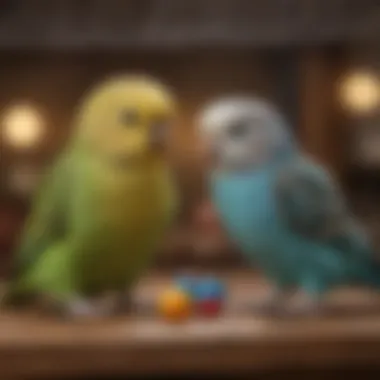
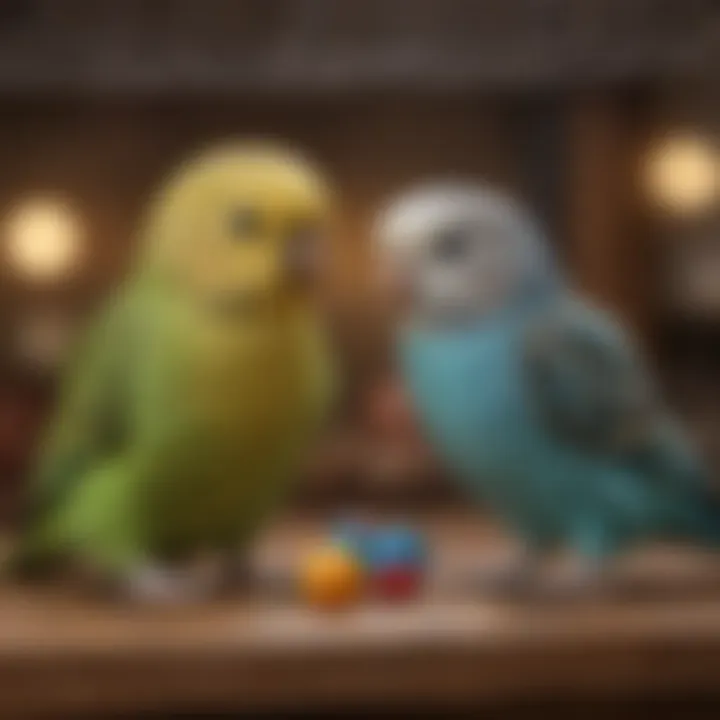
Ultimately, navigating these social requirements forms the backbone of responsible bird care, showcasing that a deeper understanding of bird behavior results in happier, healthier pets. Owners are urged to reflect on both the nuances of bonding with their birds and the potential benefits of additional avian companionship as they seek to provide the best care possible.
Impact of Loneliness on Bird Health
The emotional and physical well-being of pet birds is a crucial aspect to consider when discussing their care, especially regarding the impact of loneliness. Birds, regardless of their species, are social creatures by nature. This means that when isolated or left alone for prolonged periods, they are susceptible to a range of health issues. Understanding this dynamic is essential for pet owners aiming to create a nurturing environment and recognize potential signs of distress in their feathered companions.
Behavioral Indicators of Stress
Feather Plucking
Feather plucking is a common behavioral issue seen in birds left alone for too long. This compulsive behavior often stems from stress, loneliness, or boredom. The act itself involves a bird pulling out its own feathers, which can lead to skin irritations or infections.
- Key characteristic: The visible absence of feathers can indicate that a bird is struggling emotionally and attempting to cope with its surroundings.
- Benefits of recognizing feather plucking: Identifying this behavior early can help owners intervene before it becomes a severe and pervasive issue. Addressing the underlying causes can restore the bird's happiness and well-being.
- Unique feature: Feather plucking is not just about physical appearance; it signals a deeper concern regarding the bird's mental state. It can create a cycle where the stress from being alone leads to more plucking, which in turn increases the bird's stress. Therefore, understanding and mitigating loneliness is vital to prevent this condition.
Vocalization Changes
Vocalization is another significant indicator of a bird’s emotional state. Changes in a pet bird’s vocal patterns can be alarming for owners. A once vocal parrot might become quiet and withdrawn, or vice versa; a shy canary might begin to chirp incessantly.
- Key characteristic: Sudden shifts in a bird's vocalization often reflect its emotional state, serving as a cry for companionship or a sign of distress.
- Benefits of monitoring vocalization changes: By observing these changes, pet owners can take proactive steps to engage their birds, providing the social interactions they crave.
- Unique feature: Vocal sounds can also indicate levels of enjoyment or stress. Thus, the need for attention and companionship is often expressed through their songs. For owners, recognizing these signs can lead to better understanding and ultimately, enhanced bird care.
Physical Effects of Isolation
Changes in Eating Habits
Isolation can also manifest itself in a bird's eating behavior. When birds feel lonely or stressed, they might eat less or, paradoxically, overeat. These changes can significantly impact their overall health and well-being.
- Key characteristic: An abrupt change in feeding habits should raise red flags for any owner. It indicates that the bird may be dealing with emotional stress related to loneliness.
- Benefits of acknowledging changes: Noticing these patterns can lead to making necessary adjustments in their care routine or environment. For instance, providing more interactive toys or changing feeding habits may help improve their appetite.
- Unique feature: This behavioral change highlights the importance of connection, as birds often mirror their emotional state in their eating habits. Understanding this can guide owners in implementing strategies that enhance comfort and reduce loneliness.
General Health Decline
Long-term isolation can lead to broader health issues, including a decline in the bird's overall physical health. Stress, compounded by loneliness, can foster a range of potential diseases or other health complications.
- Key characteristic: Signs of general health decline may include lethargy, feather deterioration, or problems with the digestive system. These elements warrant serious attention from the bird owner.
- Benefits of recognizing general health decline: Early detection can lead to preventative care and facilitate timely visits to the avian vet. Staying ahead of potential health risks can save a bird not only from discomfort but possible medical emergencies.
- Unique feature: Health decline as a direct result of loneliness emphasizes the vital connection between emotional and physical health in birds. This correlation serves to reinforce the need for regular interaction and social stimulation to maintain their health.
Understanding the signs of stress and the physical health implications of loneliness allows bird owners to take a proactive stance in their pet’s care. Maintaining a nurturing environment can significantly contribute to a happier and healthier life for their feathered friends.
Species-Specific Considerations
Understanding the species-specific needs of pet birds is crucial when contemplating leaving them alone. Different bird species exhibit varying social behaviors, environmental needs, and adaptability to solitude. This section explores these differences, focusing on the distinct characteristics of social birds like parrots and budgies, as well as less social species such as canaries and finches.
Social Birds: Parrots and Budgies
Caring for Highly Social Species
Parrots and budgies are well-known for being exceptionally social, thriving on interaction with their owners and peers. This characteristic makes them both captivating pets and challenging ones to care for when left alone. Parrots, such as African Greys and Macaws, are not just intelligent but also require constant mental stimulation. Their social nature means that being left alone can lead to feelings of distress or boredom. In this article, understanding their needs helps pet owners provide a fulfilling environment.
For budgies, interaction includes mimicry and playful behaviors that require engagement. The lack of adequate socialization can result in severe behavioral issues. Owners must recognize these aspects to ensure that their birds are stimulated and happy, especially during times of solitude. With social birds, it's not just about feeding and watering; the emotional bond and regular interaction are paramount for their mental health.
Best Practices for Leaving Them Alone
When it comes to best practices for leaving social birds alone, a few strategies can help ease the process and mitigate loneliness. One key strategy is to provide various toys that challenge their minds. For instance, puzzle toys that dispense treats can keep them occupied for hours. Establishing a routine associated with play and feeding times can help them anticipate the owner's return and lessen anxiety during absences.
Setting up an audio-visual environment can also help. Consider leaving a radio on or a video featuring other birds to create a natural feeling of company. But there will be a variety of opinions about this; some bird owners prefer to design environments that mimic natural habitats instead. This can be beneficial as it offers a stimulating atmosphere, but it might not substitute the interaction they truly need.
Less Social Birds: Canaries and Finches
Understanding Their Autonomy
When thinking of less social birds like canaries and finches, a different perspective arises. These birds have a more independent nature, often enjoying solitary time without showing significant signs of stress. Understanding this autonomy is crucial for bird owners when evaluating how long these species can be left alone. They often engage in self-entertainment, making them well suited for situations where the owner is frequently away.
A key characteristic of canaries and finches is their ability to thrive in solitude. Typically, they don't need constant interaction and can feel secure in their routines. However, while they have an admirable level of self-sufficiency, such autonomy does not completely remove the necessity for interaction and stimulation. It is important to ensure they have toys and a well-designed cage to keep them engaged during long hours of solitude.
Minimizing Isolation Effects
Even though canaries and finches can handle being alone, there are still measures owners can take to minimize potential isolation effects. Providing multi-level perches and toys that encourage exploration are great ways to maintain their engagement. In particular, rotating toys and introducing new elements can keep their environment fresh and interesting, which is necessary for their well-being.
Another beneficial practice is ensuring these birds have set feeding and interaction schedules, so they know what to expect. An established routine can lead to a sense of security that continues to nurture their independence. Simply put, knowing their owners will return helps their confidence and alleviates any fear of abandonment.
"Understanding the differences between species helps owners tailor their care approach, maximizing both the well-being of the birds and the owner's peace of mind."
Preparing for Time Apart
When it comes to leaving our feathered friends alone, preparation plays a critical role in ensuring their well-being. The act of preparing your pet bird for periods of solitude is more than just a logistical task; it’s about creating an environment where they can thrive even in your absence. This phase involves considering their emotional and physical needs, and taking steps to mitigate any potential stress they may experience.
By investing time and thought into how they will spend their idle hours, you ultimately support their happiness and health during your brief departures.
Creating an Enriching Environment
Toys and Activities
Toys and activities hold a paramount place in keeping pet birds engaged, especially when left alone. Providing a variety of toys—such as perches, chewable wooden items, or foraging puzzles—can significantly enhance their quality of life. Birds are naturally curious creatures, inclined to explore their surroundings. By placing multiple toys within reach, they have the opportunity to interact and stimulate their minds by playing and discovering new things. A unique aspect of these interactive toys is the unpredictable challenge they provide, which can keep boredom at bay. However, be mindful that not every bird will engage with toys in the same manner. Some species may prefer to chew, while others enjoy puzzles that require problem-solving skills. Giving your pet a selection ensures they find what captures their interest most, helping to keep them busy while you’re away.
Visual Stimulation
Alongside toys, visual stimulation plays a vital role in creating an engaging environment. Birds often thrive on visual cues, whether it be watching passing cars outside the window or seeing an array of colorful objects in their cage. By incorporating items that catch their eye—like mirrors, colorful fabric, or bird-safe mobiles—you can promote a positive atmosphere for your feathered companion. The key characteristic of visual stimulation is that it can captivate their attention for extended periods. Bright colors and moving elements can help distract them from the absence of their owners. Still, one must be cautious. Too much stimulation could lead to overexcitement or anxiety, so balance is of the essence here.
Establishing a Routine
Consistent Feeding Times
Feeding schedules are another cornerstone of preparing your bird for time alone. Establishing consistent feeding times not only helps maintain their health but can also provide a sense of stability for them. Birds, like many pets, thrive on routine, and knowing when their nourishment arrives can reduce anxiety surrounding your absence. The familiar predictability of their meals helps them understand that despite your being away, they are taken care of.
However, be careful to avoid sudden changes in these times, as it could lead to confusion or stress. A gradual adjustment to feeding schedules, if necessary, ensures a smooth transition.


Predictable Interactions
In addition to feeding, predictable interactions can help bolster your bird's confidence. Birds are social by nature, and establishing a routine for engagement, such as daily playtime or designated training sessions, can help them feel valued. These interactions become a touchstone in their day, something they can rely on, even when you are not around. A regular pattern can also facilitate training, as consistency promotes learning.
Yet, it’s important to remember not to overextend your commitment to these interactions. Set realistic goals, ensuring you can always return to these habits, thus preventing feelings of abandonment or disruption.
In preparing for time apart from your bird, always strive for a balance between stimulating their environment and maintaining a sense of stability. Your pet's comfort is ultimately a reflection of the thought you put into their care.
By thoughtfully considering these aspects—creating an enriching environment and establishing a routine—you empower your pet bird to be more comfortable with their alone time. Although leaving them can stir feelings of uncertainty, implementing these strategies equips them to handle the absence with less anxiety.
Duration and Frequency of Absences
Understanding the duration and frequency with which pet birds can be left alone is crucial for any bird owner. Birds, by their nature, are social creatures. Their well-being hinges on not just food and water, but also interaction and environment stimulation. Leaving them alone, whether for short errands or extended trips, requires careful consideration of both the time spent apart and the strategies employed during that time. This section aims to dissect these elements, offering a comprehensive guide for bird owners to maintain their pet’s morale and health.
Short Absences: Impacts and Strategies
Preparing Your Bird for Brief Periods
When it comes to leaving your bird for short stints, such as a trip to the grocery store or a brief meeting, preparation can make a world of difference. The core aspect of preparing your bird for these brief periods involves gradually accustoming them to being alone. Letting them stay in their cage for increasing increments while you remain just out of sight is a good start. This method not only builds their confidence but also reduces stress when they find themselves alone.
A key characteristic of this approach is its adaptability. Each bird is unique, so understanding your feathered friend's specific needs and response is vital. This individualized strategy is beneficial because it tailors to your bird's specific comfort levels and anxiety triggers, allowing for a smoother transition to solitude.
One unique feature of properly preparing for short separations is the increase in your bird’s sense of security. By understanding that their owner will return, birds often exhibit calmer behavior during these brief lapses. However, neglecting this preparation can lead to anxiety, which may manifest in undesirable behaviors like excessive screeching or even feather picking.
Signs of Adaptation
Identifying the signs of adaptation in your bird provides essential insights into their comfort level with solitude. Birds showing confidence when left alone—such as calmly engaging with toys or even chirping lightly—indicate they are adapting well to such brief absences. The ease with which they adapt reflects their emotional resilience, a trait worth nurturing.
A key characteristic of recognizing these signs is vigilance. Observing how your bird interacts with its environment when you’re away reveals much about their disposition. Perhaps it is a beneficial choice for this article to stress that awareness leads to informed decisions about future absences.
A unique feature to consider is that adaptation doesn't happen overnight. While frequent brief absences can help in training, the signs may vary from one bird to the next. A parakeet, for instance, may adapt quicker than a more sensitive cockatoo. Keeping an eye on their behavior during these intervals can help identify whether your bird is genuinely adapting or struggling with the change, which could influence the strategies that follow.
Longer Stays Alone: Considerations
Identifying Care Options
When plans draw you away for longer periods—say, a weekend trip or a vacation—it's imperative to identify suitable care options for your bird. Whether enlisting a friend, hiring a pet sitter, or using a boarding service, recognizing who can take care of your feathered companion is a key aspect of their welfare during extended absences. Knowing the characteristics of potential caregivers is just as important as choosing the right place for them to stay.
This approach stands out because it ensures your bird remains in a familiar setting, with a caregiver who understands their needs. The advantage here is twofold: birds thrive in their environments and caregivers can monitor them closely, helping to reduce the stress of separation.
However, the downside may lie when the chosen individual is inexperienced. A caregiver who lacks knowledge about birds’ behavior or dietary requirements could inadvertently cause distress in your pet, leading to complications that far outweigh the benefits of your absence.
Alternatives to Leaving Birds Alone
If leaving your birds alone feels like too big of a gamble, consider alternatives that can alleviate the stress of separation while still allowing you to live your life. Taking birds along when feasible is one option—some hotels are pet-friendly, or if you have family nearby, they might accommodate your feathered friend for a time.
Key here is the ability to tailor your living arrangements to keep your bird as comfortable as possible. Utilizing family members or friends who adore animals often helps avoid the guilt of leaving birds alone altogether.
The choice to bring your bird wherever you might go also presents challenges, especially regarding travel logistics and unexpected situations that might arise. Yet, it amplifies one major advantage: your bird feels secure, surrounded by loved ones engaged in their care. Thus considering every possible avenue can lead to balanced decisions that benefit both you and your cherished pet.
When Is It Unacceptable to Leave Birds Alone?
Leaving pet birds alone can be a tricky business. It's not just a matter of stepping out for a quick errand. Understanding when it’s downright unacceptable to leave these creatures unattended is crucial for any responsible bird owner. Birds are social beings by nature and thrive on interaction, both with their owners and potentially with other birds. Certain situations call for extra consideration. Not all absences are created equal, and there are specific contexts where leaving a bird alone can have negative consequences on their well-being. This section digs deep into the risks of absence, with a focus on timing and health considerations, laying out situations where extra caution is warranted.
Recognizing Risks of Absence
Being aware of the risks associated with leaving birds alone is half the battle. Several factors influence how an absence can impact our feathered friends, making it important to think carefully about when to leave them alone.
Specific Times of Year
Certain times of year can exacerbate the effects of loneliness in birds. For example, during the holidays, pet owners might be preoccupied with family gatherings or travel plans, making it easier to forget the needs of their birds. Another time of concern is the peak of summer, when high temperatures could put additional stress on a solitary bird left alone in a hot environment. This is particularly true for sensitive species that might not tolerate heat well. Also, changes in routine during festive times can unsettle birds, leading them to express stress in various ways.
It's vital to take into account the unique features associated with these times; they often create erratic schedules that birds aren't accustomed to, heightening their anxiety.
Health Considerations
Health plays a significant role when considering leaving birds home alone. A pet bird that is feeling under the weather may require more attention and care than one that is healthy and active. If a bird has a medical condition, like diabetes or respiratory issues, the potential impact of isolation could be severe. Monitoring food intake and ensuring access to clean water becomes even more critical in these scenarios. Leaving a sick bird alone may lead to deterioration in their health. Thus, understanding the key characteristics and unique features of your bird's health can guide your decisions about when it’s absolutely necessary to stay home, ensuring their well-being is prioritized.
Emergency Situations: What to Do
Even the best-laid plans can go awry, and emergency situations can arise when you least expect them. Knowing how to respond to such instances is paramount to the safety and happiness of your bird—swift action can often mitigate negative effects.
Seeking Professional Help
When faced with an emergency, consulting a veterinarian is often the best course of action. A vet can provide guidance tailored to your bird’s specific needs and condition. The characteristic advantage of seeking expert help is the assurance that your bird receives professional care, especially if you are unsure whether they may be experiencing distress. Quick access to professional resources is an invaluable asset; however, it could involve financial considerations and logistics, making it essential to weigh these aspects while ensuring your bird’s needs are met.
Involving Trusted Friends or Family
Another proactive approach during emergencies is involving trusted friends or family members who can look after your bird in your absence. Relying on someone familiar with your bird’s needs can act as a bridge during tough times. They might bring comfort to the bird, even if the primary caregiver isn’t present. Besides, having a reliable contact can mean less stress for you, knowing your pet is in capable hands. The unique benefit of this option is that it often eliminates the need for expensive boarding facilities. However, it does require ensuring that the caregiver knows how to handle your bird, reinforcing the need for clear instructions.
In this complex journey of pet care, it's important to stay tuned into your bird's needs and the factors surrounding your absence. Their emotional and physical health hinges on the choices you make regarding their care.
With a better understanding of when it becomes unacceptable to leave birds alone, pet owners can make informed decisions that prioritize the health and happiness of their feathered companions.
Addressing the question of whether pet birds can be left alone isn’t simply about stating a yes or no. It’s about understanding the intricate dynamics of bird behavior and their unique needs. The importance of this topic cannot be overstated, as it touches on the well-being of our feathered friends in a world where human obligations often require us to be away from home. Striking a balance means creating an environment where birds can thrive even during times of solitude.
Evaluating Your Bird's Needs
To comprehend how to leave your pet bird alone, it’s crucial to evaluate its specific needs. Each bird species has its own social structure and behavior. For instance, a parrot, with its high intelligence and social nature, is more likely to feel stressed when left alone than a finch that may exhibit more independence. Observing your bird's personality can provide insights:
- Activity Level: Is your bird active and curious, or more laid-back? This helps dictate how much enrichment they need when you're away.
- Vocalization Patterns: Some birds may vocalize more when they feel lonely, a clear signal that they need more interaction or distractions.
- Play Preferences: Take note of its favorite toys or activities. Providing a variety of engaging items can alleviate boredom during absences.
Each of these aspects contributes to a holistic understanding of what your bird needs to manage time alone effectively.
Making Informed Decisions
Making informed decisions involves understanding both your lifestyle and that of your bird. When contemplating leaving your bird unattended, consider the following questions:
- Duration of Absence: How long will you be gone? Short durations may allow for different strategies compared to long-term separations.
- Bird's Age and Health: An older or ailing bird may struggle with solitude more than a young, healthy one.
- Environmental Enrichment: Have you set up an engaging environment filled with stimulating toys and activities?
The choices you make will ultimately influence how your bird copes with solitude. If you find that leaving your bird is unavoidable, consider employing alternatives like hiring a bird sitter or asking a friend to interact with your pet during your absence. These proactive measures can significantly enhance your bird’s experience of solitude.
Remember: A happy bird is a balanced bird. Ensuring your feathered companion has what it needs when you’re not around makes the time apart less daunting for both of you.















